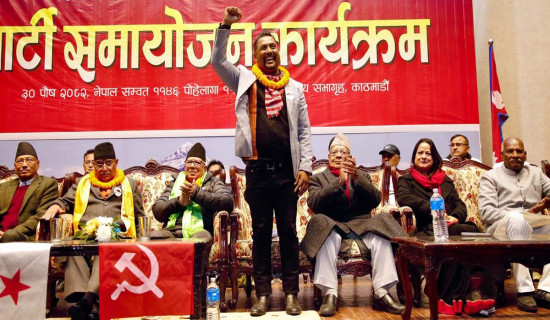- Wednesday, 14 January 2026
The music of the valley
Kathmandu, Dec. 25: “Melodies words cannot describe; tunes that demand to be felt, not heard; rhythms so divine that even the gods in heaven cannot help but come down among mortals to rejoice in the music,” Hari Krishna Maharjan, 84, tried to put what he called the experience of Dapha into sentences.
“A transcendent orchestra of musical instruments unlike any other” that not only plays the classical Sa, Re, Ga, Ma, Pa, Dha, Ni, Sa scales but also the notes that lie between them, Maharjan, a former ‘Dapha musician’ himself, elucidated. “It flows mellifluously into an empyrean domain where it is impossible to distinguish where existence ends and ecstasy begins and we become one with the great almighty.”
“Wow,” with his eyes closed and head tilted backwards, Maharjan let out an exclamation, “Dapha!”
Unfortunately, it is this ethereal composition that now stands as a major challenge to Dapha’s conservation. As Pushpa Palanchoke, a scholar of applied ethnomusicology, worried, the present musical world is so dominated by the equal tempered scale developed in Europe that anything that goes beyond, like this extraordinary music, cannot be comprehended.But before proceeding further, let us take a step back and, while we have Palanchoke with us, understand what Dapha is.
“Put simply, Dapha is the music of [Kathmandu] Valley,” she explained. “A distinctive style of music that has been practised by the indigenous Newa communities since at least the 15th Century and features songs dating back as early as the 12th Century.”
Played by community ensembles known as Dapha Khalahs, Dapha is intertwined with the urban, spiritual and seasonal lifestyles of the Newa people and features three main musical instruments: Khi, Tah and Baucha.
Palanchoke further shared that Dapha was considered the parent from which most other genres of traditional music played in the Nepal Mandala (mediaeval confederation of kingdoms and settlements consisting of present-day Kathmandu Valley and surrounding areas sharing commonalities in culture, religion and politics) originated.
Like most South Asian music, Dapha is based on the Raag and Taal systems. Unlike them, Dapha performances are definitive and structured with no room for melodic improvisation. But this does not mean that there is no diversity. There is. Each Dapha Khalah has its own way of performing and even the same song may be played differently in different localities.
Moreover, while no one has many any particular claims about the origins of the term ‘Dapha’, which denotes both the music played and the songs sung by the Khalahs, Palanchoke believes that the name could have been derived from the frame drum Dafa or be an indication of the fact that it is sung in rows Dafaa.
It is truly astounding just how many elements of the Valley’s intangible culture, including its folk dances, devotion, worship, festivals and more, Dapha binds together and the centuries of musical knowledge it encapsulates. At the same time, it is equally frightening its present situation of decline, brought on partly by the aforementioned domination of the tempered scales.
“It’s like pouring water in a vessel. No matter what its properties, the water is forced to take the shape of its container,” Palanchoke gave an example. “Our comprehension is so rooted in tempered scales today that it is getting ever difficult to grasp the pitches, frequencies and melodies of Dapha. Our musical instruments, for instance harmoniums, are designed based on the tempered scales that they cannot adequately play the tones required in Dapha. The musical water is being metaphorically poured into the Euro-centric vessel.”
There are other challenges too, such as the lack of inter-generational skill transfer and the disappearance of Dapha Khalahs that Palanchoke uncovered when she researched the tradition for a project in 2020. The project was ultimately scrapped because of the COVID-19 pandemic that hit the country that year but Palanchoke and her team had collected so much knowledge and had dived so deep into the subject that they felt they had to do something to protect it.
And thus was born Dapha Calling (DC) – a forum to involve the Dapha Khalahs of various communities, bring their knowledge and customs to the forefront, give them a platform to perform and create an understanding of this indigenous harmonic tradition.
Working with the Ta: Nani Dapha Khalah of Kirtipur, Palanchoke, through the community-based arts programme Folk Lok, held the first iteration of DC online in 2020. Since then, it has become an annual – and now physically-organised – event that has been growing every year in the number of Khalahs and stakeholders it engages and the topics it explores.
The third edition of the programme was held this year in the Bhandarkhal courtyard of Patan Museum, Lalitpur from December 9 to 17. It was organised by Folk Lok, Ta: Nani Dapha Khalah and Shree Balkumari Dapha Khalah (of Panga, Kirtipur) and supported by Satori Centre for the Arts (Folk Lok is a programme under Satori), US Embassy Book Bus and Social Science Baha. It featured discussions on federal and local policies to support artistic creations and revitalising Dapha music, seminars on archiving Nepal’s musical heritage and the performance of the folk-dance Kha Pyakha.
This year’s Dapha Calling also included an exhibition whose title this news has borrowed for its headline, where, among other things, was on display a replica of a Paubha painting
from 1664 AD.
The painting depicted King Pratap Malla weighing his son against silver in front of the Taleju Temple in Kathmandu in a ceremony known as Tuladaan. The picture also showed a Dapha Khalah which, as per the exhibition curators, is the oldest visual record of a Dapha band. In the image, the Dapha band is placed above other musicians – something that supposedly signifies the high regard they were placed in by society back then.
For reasons varied and nuanced, those glory days are long gone. But Dapha, as a tradition, need not be. And here is where the pesky equal tempered scales present a tragic fork in the road. “Not adapting to the omnipresent scales now risks making our native music obsolete. But in adapting to them, we are bound to lose a certain amount of depth and richness that the western scales were not designed to accommodate,” Palanchoke was nervous. Despite appearing to be almost antonyms, we may end up having to accept conservation with loss.














